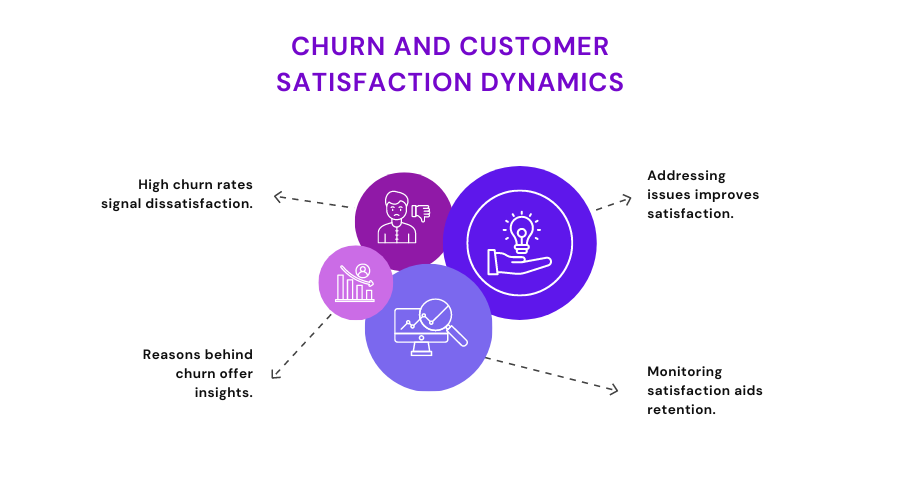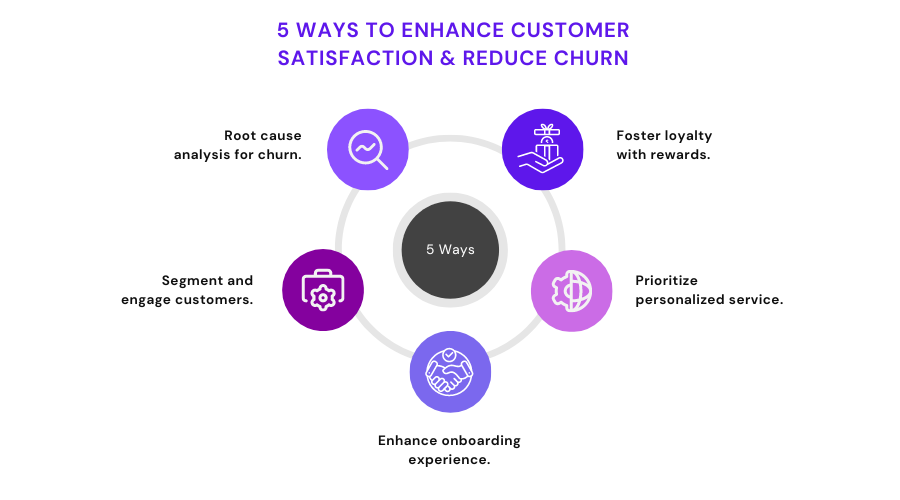How to Improve Customer Satisfaction and Reduce Churn

Are you struggling with losing clients? Do you constantly search for solutions to improve customer satisfaction and reduce churn? Without effective churn management strategies, your business will be like a leaky boat, taking on water faster than you can pump it out.
Customer satisfaction is essential for businesses to thrive and succeed. With every lost client, your business loses revenue and reputation.
Patricia Fripp once said, “It is not your customer’s job to remember you. It is your obligation and responsibility not to let them forget you.”
How do you keep them happy? Dont worry. We bring the tried and tested strategies to help you turn things around. In this article, we will discuss all the secret recipes needed for churn management to ensure you delight and retain customers. Are you ready?

The Key Factors That Affect Customer Satisfaction and Churn
Here are some of the critical factors that affect customer satisfaction and churn:
- Value perception: Customers must feel they are getting good value for the price. Pricing viewed as too high can lead to dissatisfaction and churn.
- Customer support: How quickly and efficiently do you address customer issues? How easy is it for them to get help? Caution! As you all know, poor support drives customers away.
- Product and service quality: The quality of the product or service is critical. Customers prefer products that fulfill their requirements. Integrity is also necessary. How well do you keep your promises to customers? High-quality products impress customers, whereas low-quality products might cause disappointment.
- Ease of use: Friction in the customer journey, such as a complex signup or onboarding process and difficulty using features, can lead to frustration and negatively impact customer satisfaction.
- Communication: How well do customers understand navigating your product? How often do you communicate about features or updates with them? If you fail this task, you are paving a path for dissatisfaction.
- Switching costs: Switching costs play a significant role in reducing customer churn. Long contracts and high exit fees can act as barriers that deter customers from leaving, even if their satisfaction with a product or service declines over time.
- Loyalty programs: Rewarding loyal customers with incentives, discounts, or exclusive offers can boost customer satisfaction and decrease churn by making customers feel appreciated.
Understanding these key factors and actively managing them can help you improve customer satisfaction and reduce churn, ultimately leading to long-term success and growth.
5 Ways to Improve Customer Satisfaction and Reduce Churn
Now that we’ve looked at the primary elements that help you reduce customer churn rate let’s take a look at what works best to make sure you’re doing everything you can to keep your customers happy.
- Getting to the Root Cause of Churns
- Segment and Engage With the Targeted Customers
- Improve User Onboarding Experience
- Prioritize Personalized Customer Service
- Fostering Customer Loyalty Through Rewards
1. Getting to the Root Cause of Churns
The first crucial step to improve customer satisfaction and reduce churn is understanding why customers have chosen to leave your business. Identifying the root cause is essential before you can effectively address the issue.
There are many reasons why customers may churn, such as:
- They are not satisfied with the product or service.
- They found a better deal from a competitor.
- They had a poor customer service experience.
- They no longer need the product or service.
- They have moved to a new area where the product or service is unavailable.
But how do you know the issue? You ask the customers! As simple as that.
As Julie Zhou said, “To find ideas, find problems. To find problems, talk to people.”
Make the best use of customer feedback tools such as surveys such as NPS, CSAT, or CES. The survey should include:
- Questions that prompt customers to share their reasons for leaving.
- Their overall experience.
- Any specific issues they encountered.
Additionally, customer support tickets can provide valuable insights into the problems that customers are experiencing. You can analyze customer support tickets to identify common problems and trends.
You can also go ahead and interview customers who have churned. They can give you a deeper understanding of their reasons for leaving. You can ask customers about their experiences with your product or service, what they liked and disliked, and why they decided to churn.
Are you in search of great software that will help you in optimizing your product feedback process? Then, Chisel is here for you. With a dedicated Product Feedback pillar exclusively focused on customer satisfaction and feedback management, Chisel has to be your best buddy.
Sign up for Chisel’s Free Forever Version here.
2. Segment and Engage With the Targeted Customers
Once you’ve identified the critical causes of customer churn, you can begin segmenting your consumers and engaging with them in greater detail. Understanding the different needs and motivations of your customers and then tailoring your messaging and interactions accordingly.
Let us start with segmentation. Segmentation is segregating your customers based on their needs and user behaviors. This way, you will be able to perform target-specific strategies, thereby reducing customer churn.
For example, suppose you are a SaaS product management company. Following customer segmentation by company size and customer journey stage, you may notice an increase in churn from smaller companies still in the early phases of utilizing your product. After that, you can focus on strategies to keep these customers, such as providing them with personalized onboarding and training resources.
Once you have figured out customer segmentation, the next obvious step is to engage with them. How else will you get them back on board? If you are not engaging with your customers, you are at considerable risk. This tactic is so crucial that the Gallup poll revealed that B2B companies with excellent customer engagement have seen a 55% higher share of wallets!
Here are some ways to increase your customer engagement:
- Familiarity with your product: Make them aware of the products and features you bring to the table. Why do the customers need to use your product? What problems are you trying to solve?
- Making the best use of marketing channels: Most effective marketing channels, such as email marketing and social media marketing, are your holy grail. Create the most effective product experience for your customers. Start sending out newsletters and conduct webinars.
- Social listening: It might seem new to you, but let us explain. Be proactive in identifying and getting involved in online discussions about your business by looking for brand references, comments, and specific keywords. This way, you will be able to understand what you need to do to increase customer satisfaction.
3. Improve User Onboarding Experience
Suppose your customers are frustrated in the initial stages of familiarizing with your products or services. How will you ever be able to reduce the customer churn rate? The onboarding process is vital to set customers up for success right from the start.
When users are new to your product, they need guidance on how it works and how it can help them accomplish their goals. A smooth onboarding helps avoid confusion and frustration that could lead to churn.
Be sure to provide thorough yet easy-to-understand documentation for new users. Give them tutorials, guides, videos – whatever helps explain the features and how to get the most value. Hold webinars or offer one-on-one training to answer questions. The goal is to help users feel confident in solving their problems from day one.
Don’t just expect people to figure it out on their own. Give them the support and education they need to understand the full potential of your solution truly. If customers start strong and feel empowered, they’re far more likely to stick with you long-term. Their success is your success, so invest in onboarding as much as possible to set users up for longevity with your product.
One of the best ways to improve the user onboarding process is to ask your customers for their ideas. What better way to do this than by using a central repository that can store all of their ideas and recommendations and that also acts as a great reference point for you? That’s what Chisel’s Idea Box is for.
Chisel’s Idea Box helps you create, manage, and prioritize your ideas.
- Create and organize your ideas with labels and categories.
- Link your ideas to features to see how they relate to your product roadmap.
- Pin your most important ideas to keep them top-of-mind.
- Prioritize your ideas so you know which ones to work on first.
Sign up for Chisel’s Free Forever Version here.
4. Prioritize Personalized Customer Service
According to McKinsey, 71% of customers now anticipate personalized experiences from businesses, and 76% express frustration when this expectation does not get fulfilled. Today’s consumers hold higher expectations for their business interactions. A data-driven personalization strategy is essential to meet and exceed these expectations.
Make every interaction count by truly knowing your customers and their unique needs. Remember essential details like their name, past orders, preferences – anything that shows you value them.
Provide a personal touch in your communications. Address customers by name, follow up on previous discussions, and tailor your messaging for them. Show that you care about their situation and are there to help however you can. When customers feel seen and heard, they’ll develop more loyalty and trust in your brand.
Have a team trained to go above and beyond. Empower your reps to think creatively about solutions instead of following scripts. Give them the flexibility to make judgment calls that surprise and delight. Customers will appreciate the effort to understand their situation and find individualized answers. Happy customers = reduced customer churn rate.
A personalized experience at every touchpoint strengthens bonds and satisfaction. You want customers to feel like more than just a number – make each interaction an opportunity to nurture essential relationships through individualized care, attention, and problem-solving tailored just for them. Their long-term loyalty will follow.
5. Fostering Customer Loyalty Through Rewards
Customer loyalty programs are a great way to encourage and reward loyal customers. These programs typically have reward criteria (e.g., the customer must spend X amount per month). Still, the benefits for the customer usually outweigh these conditions.
There are many different types of customer loyalty programs. Still, they all share the same goal: to reward customers for their continued business. Some common rewards include redeemable points for discounts or free merchandise, exclusive access to sales or events, and early access to new products.
Customer loyalty programs can be very effective in increasing customer satisfaction and reducing churn. When customers feel you are rewarding them for their loyalty, they are more likely to continue doing business with the company. They are also more likely to recommend the company to their friends and family.
If you are considering implementing a customer loyalty program, there are a few things you should keep in mind:
- Make sure that the program is easy to understand and participate in.
- Offer rewards that are valuable to your customers.
- Make it easy for customers to redeem their rewards.
- Promote your customer loyalty program to your customers and encourage them to participate.
For example, if you are a SaaS company, you can offer a tiered reward program with the following levels:
- Bronze: Access to exclusive content and webinars
- Silver: Free training on new features
- Gold: Priority support and account management
- Platinum: Custom consulting and discounts on future purchases
Ultimately, the best loyalty reward programs are those that are relevant and valuable to customers and that help the business achieve its goals.

Key Takeaways
No one is denying the fact that attracting new clients is important. But you cannot ignore the existing ones. It is far more cost-effective to nurture the customers one already has through exceptional service and satisfaction. However, many organizations struggle with a problem that jeopardizes this goal: reducing customer churn.
Addressing why customers abandon a product or service is the first step towards prevention. This article explored the root causes of churn and offers a holistic strategy for tackling the issue head-on. By segmenting your user base, enhancing onboarding, providing personalized support, addressing pain points, and rewarding loyalty, you can significantly reduce churn rates.
But the work cannot end there. To adapt to changing needs and continuously innovate, deep customer insights are vital.
An insightful product management software like Chisel enables ongoing dialogue and collaboration. With features that gather feedback and shape product roadmaps, Chisel empowers businesses to listen intently and tailor offerings accordingly.
If you are ready to stem the tide of churn and propel your enterprise forward, the time for action is now.
Visit Chisel to discover how their tools can revolutionize your approach to satisfaction. Understanding customers through their lens will fuel your evolution and growth for many years to come. Take the first step towards ensuring success by contacting Chisel without delay.
